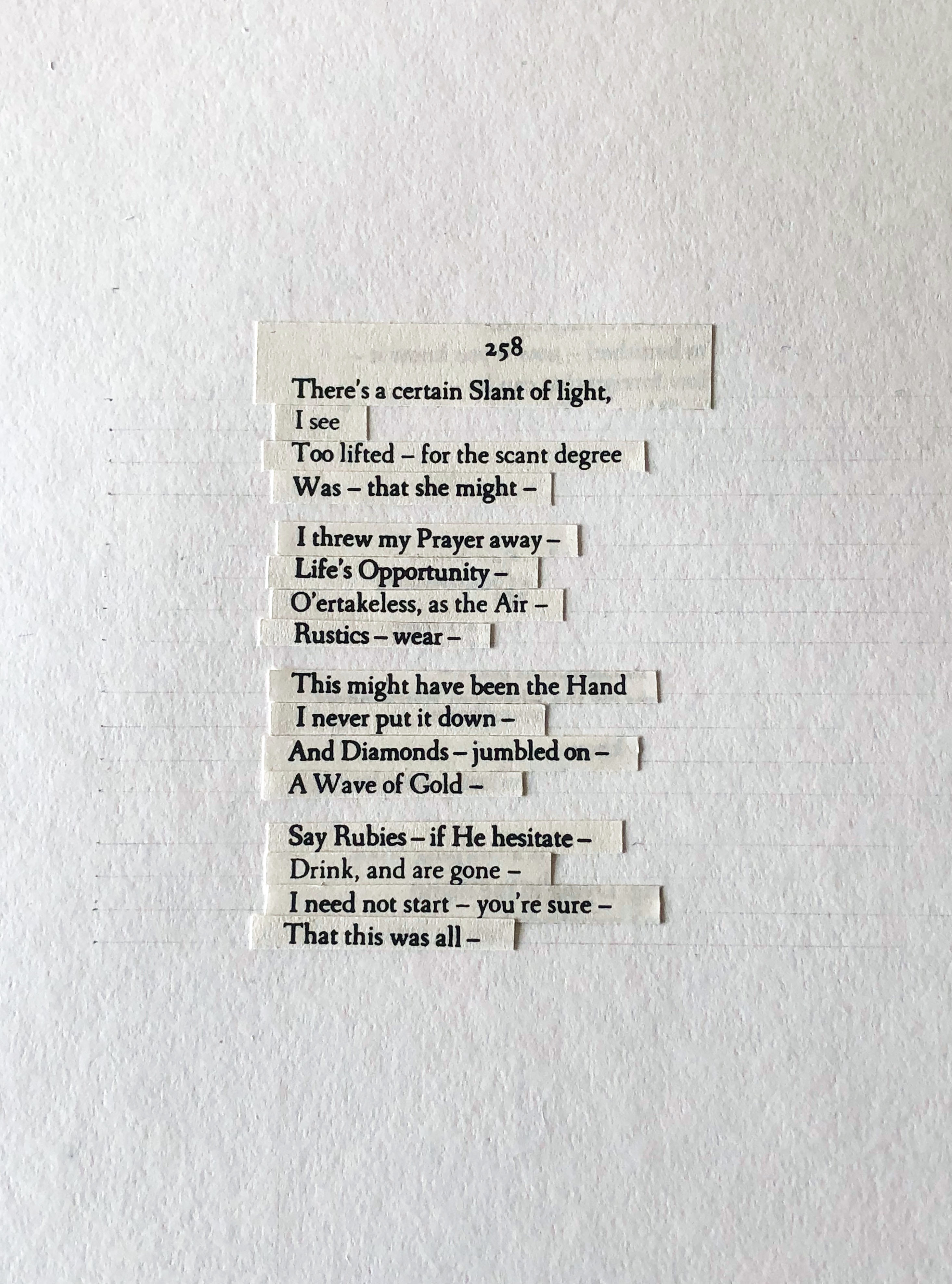Untitled Dickinson Poem (There's a certain Slant of light)
2020
Collage, book on paper
420x297mm
These collages take as their starting point — and their material — the poems of Emily Dickinson (1830–1886). Dickinson often composed her poems on scraps of paper, such as torn pieces of envelope, and these works return them to their original state of materiality.
The process by which these works are made is both simple, and laborious. A poem of Dickinson’s is chosen, the first line of which is then used to generate the rest of the work. For example:
Come slowly — Eden!
I then search through Dickinson’s poems to find those occasions where a line ends with the same word, ‘Eden’; this occurs a number of times, including:
There must be guests in Eden —
…
Soft fall the sounds of Eden
…
Do they wear ‘new shoes’ — in ‘Eden’ —
Each time an instance is found, I make note of the line which follows, as in these cases:
All the rooms are full —
…
Upon her puzzled ear —
…
Is it always pleasant — there —
A choice is then made from these lines — ‘Is it always pleasant — there —’ — and the procedure is repeated. Sometimes a word comes at the end of a line on only a couple of occasions, while at other times it does so many times, and so offers many different options. (Sometimes, a word will only come at the end of a line on a single occasion, and so that line cannot be chosen, as it would bring the process to an end.) ‘There’ is one of those words which occurs often at the end of a line, and so a long list of the options must be produced, from which one is chosen. The process is then repeated until a new ‘poem’ is produced of the same form as the original, in this case, a single stanza of only four lines.
Dickinson’s own distinctive use of dashes aids this process of rearrangement, her lines made up of aggregated phrases which are more easily placed in new configurations; indeed, on many occasions Dickinson produced different versions of her poems which contained variant lines, phrases, or words.
The lines may be chosen during this process for a number of reasons, such as the meaning produced, or the rhythm or sonorous qualities when read. Sometimes the chosen lines may reproduce the rhyming schema of the original poem; at other times the process may suggest the inclusion of a line from a poem which was quoted earlier. In such cases it is as if an echo of the original has been heard, but not quite, and in so doing something recognisable but wholly new has come into being.
2020
Collage, book on paper
420x297mm
These collages take as their starting point — and their material — the poems of Emily Dickinson (1830–1886). Dickinson often composed her poems on scraps of paper, such as torn pieces of envelope, and these works return them to their original state of materiality.
The process by which these works are made is both simple, and laborious. A poem of Dickinson’s is chosen, the first line of which is then used to generate the rest of the work. For example:
Come slowly — Eden!
I then search through Dickinson’s poems to find those occasions where a line ends with the same word, ‘Eden’; this occurs a number of times, including:
There must be guests in Eden —
…
Soft fall the sounds of Eden
…
Do they wear ‘new shoes’ — in ‘Eden’ —
Each time an instance is found, I make note of the line which follows, as in these cases:
All the rooms are full —
…
Upon her puzzled ear —
…
Is it always pleasant — there —
A choice is then made from these lines — ‘Is it always pleasant — there —’ — and the procedure is repeated. Sometimes a word comes at the end of a line on only a couple of occasions, while at other times it does so many times, and so offers many different options. (Sometimes, a word will only come at the end of a line on a single occasion, and so that line cannot be chosen, as it would bring the process to an end.) ‘There’ is one of those words which occurs often at the end of a line, and so a long list of the options must be produced, from which one is chosen. The process is then repeated until a new ‘poem’ is produced of the same form as the original, in this case, a single stanza of only four lines.
Dickinson’s own distinctive use of dashes aids this process of rearrangement, her lines made up of aggregated phrases which are more easily placed in new configurations; indeed, on many occasions Dickinson produced different versions of her poems which contained variant lines, phrases, or words.
The lines may be chosen during this process for a number of reasons, such as the meaning produced, or the rhythm or sonorous qualities when read. Sometimes the chosen lines may reproduce the rhyming schema of the original poem; at other times the process may suggest the inclusion of a line from a poem which was quoted earlier. In such cases it is as if an echo of the original has been heard, but not quite, and in so doing something recognisable but wholly new has come into being.

